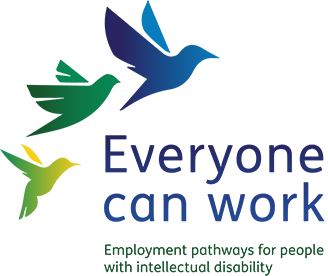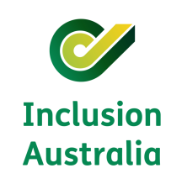What is interagency collaboration?
Interagency collaboration is defined as:
key people from school personnel, family members, businesses, and human service agencies working together to promote successful post-school outcomes (Steere, Rose, and Cavaiuolo, 2007 quoted in Taylor et al., 2016, p.163).
The problem
There is consistent reference in the research from multiple countries, and in Australia, to the problem of the complexity of the employment and education systems (e.g. ACIL Consulting, 2017; Foley et al., 2012). This creates difficulties for people with disability, their families and also for service providers in navigating this complex landscape, for which there is ‘currently no guide’ (ACIL Consulting, 2017, p.28). International research has highlighted concerns, echoed by Australian research (ACIL Consulting, 2017), in regard to:
the difficulty students and their parents face navigating services across different programs during the transition to adult life, limited coordination across agencies, and a lack of information about the full range of service options available to young adults with disabilities (Hall et al., 2018, p.209).
The solution
In response to these issues, calls for greater collaboration and coordination across programs and services have been consistently made by researchers in multiple countries (for example, Hall et al. 2018; Kohler & Field, 2003; Molfenter et al., 2017).
The principles for successful school to work transition (Kohler, 1996) highlight the importance of inter-agency collaboration as an underpinning to programs supporting transition to work or post-school education.
Interagency Collaboration practices … facilitate involvement of community businesses, organisations, and agencies in transition education including interagency agreements that articulate roles, responsibilities, communications, and other strategies to foster collaboration and enhance curriculum and program development (Wakeford & Waugh, 2014, p. 21).
Kohler & Field (2003), US researchers in this field, document a number of research studies that confirm
that interagency collaboration and support for individual students in transition and their families is a factor so important that when done well, it facilitates achievement of transition goals, and when done poorly, it limits or impedes those goals (p.178).
Similarly, a more recent US study confirms:
Interagency collaboration is well established as a predictor of employment outcomes during transition (Butterworth et al., 2017, p.266).
Interagency collaboration can occur at several levels: 1. around a single school and its students, 2. on a broader local or regional basis, 3. at the level of State policies and programs (Butterworth et al. 2017).
Interagency collaboration can also be addressed on a wider basis than an individual school collaborating with individual businesses, post-school service and educational providers. Community transition teams consisting of secondary school transition personnel, post-school providers, employer groups, parents, chambers of commerce can identify common goals, address local transition issues and work together to solve the transition problems that exist in local communities (Meadows, 2012 quoted in Wakeford & Waugh, 2014, p.26).
The key strategies used by collaborative partnerships include:
- provision of training,
- coordinated referral,
- co-location (i.e. employment/transition specialist placed in school),
- holding joint meetings between individual with disability, service providers, school and other stakeholders,
- creating inter-agency collaborative teams (to support transition activities and employment placement)
- creating and sharing resources and information for all stakeholders
- hosting a community transition committee to coordinate activity
- sharing funding (Taylor et al., 2016)
- cross pollinating ideas and brainstorming strategies to overcome barriers
- involving young people with disability as self-advocates (Molfenter et al., 2017).
Programs that work
Two successful Australian programs that are based on supporting this cross sector coordination are the National Disability Coordination Officer (NDCO) Program and Ticket to Work.
National Disability Coordination Officer (NDCO) Program
The NDCO Program is a national program, run through 31 local networks, that aims to build linkages and information in local regions to support the transition of young people with disability from school to post-secondary education and employment (ACIL Consulting, 2017).
The NDCO Program was introduced in response to difficulties faced by people with disability in navigating a complex system of fragmented, overlapping services across the disability, education and employment sectors. The program seeks to build links and coordinate services to reduce systemic barriers — including community attitudes — to participation in education and employment by people with disability (ACIL Consulting, 2017, p.16).
Both employment and participation in post-secondary education by young people with disability have increased in the majority of regions in which the NDCO Program is operating ((ACIL Consulting, 2017).
The program has a primary focus on working with services (including schools, post-secondary education providers, and others) rather than working at a case management level with individuals with disability (though there remains flexibility to work directly with this group as well as families and carers). Key elements in the way the program is run include:
- Impartiality of information on education and employment options;
- Local coordination and strategies that ‘discourage organisations to work in silos’, reduce duplication in services, and encourage coordinated work to address service gaps and systemic change;
- Networking and linkages across sectors to improve service quality as well as increase the employment and training options available;
- Ongoing awareness and training about programs and best practice (ACIL Consulting, 2017, p.21).
Ticket to Work
Ticket to Work is a national program of the National Disability Services, Australia, that supports networks of partners in local regions to provide opportunities for young people with disability to build employability while they are at school (mainstream or special schools) (ARTD Consultants, 2019). Partners include schools, Disability Employment Services, TAFE/RTOs, employers, disability services and others, who
work together to provide young people with access to career development, workplace preparation, work experience, vocational skills and Australian School Based Apprenticeships and Traineeships (ASbATs). Essentially each Local Network supports young people with disability to participate in the same ‘typical’ transition to employment activities that their non-disabled peers generally partake in (Wakeford & Waugh, 2014, p. 6).
These networks bring together expertise from a range of sectors (education, industry, disability, employment, training, youth). Wakeford & Waugh (2014) suggest that the program
has evidence that partnerships comprised of schools, employers, employment services, disability agencies and youth services do create more pathways opportunities for young people collectively than they do if working individually or discretely (Wakeford and Waugh, 2014, p. 26).
Two evaluations of Ticket to Work have evidenced that it is a successful transition model, with participants being more likely to be employed (64%) than the comparison group (33%), as well as be more likely to complete year 12, undertake post-secondary education, be more socially active and more independent (ARTD Consultants, 2019).
References
ACIL Allen Consulting, (2017) National Disability Coordination Officer Program Evaluation, https://docs.education.gov.au/node/46076
ARTD Consultants. (2019). Ticket to Work Post School Outcomes. Report for National Disability Services, Final Report, Sydney, Author, https://tickettowork.org.au/media/uploads/2020/03/03/ticket-to-work-post-school-outcomes-final-2019.pdf
Butterworth, J., Christensen, J., & Flippo, K. (2017). Partnerships in employment: Building strong coalitions to faciliate systems change for youth and young adults. Journal of Vocational Rehabilitation, 47, 265-276. doi:10.3233/JVR-170901
Foley, K. R., Jacoby, P., Girdler, S., Bourke, J., Pikora, T., Lennox, N., . . . Leonard, H. (2013). Functioning and post-school transition outcomes for young people with Down syndrome. Child: Care, Health And Development, 39(6), 789-800. doi: 10.1111/cch.12019
Hall, A.; Butterworth, J.; Winsor, J.; Kramer, J.; Nye-Lengerman, K. and Timmons, J. (2018). Building an Evidence-Based, Holistic Approach to Advancing Integrated Employment, Research and Practice for Persons with Severe Disabilities, Vol. 43(3) 207–218.
Kohler, P. D. (1996). Taxonomy for transition programming: Linking researchand practice. Champaign: University of Illinois at Urbana-Champaign,Transition Research Institute
Kohler, P., & Field, S. (2003). Transition-Focused Education: Foundation for the Future. The Journal of Special Education, 37(3), 174-183.
Molfenter, N.F, Hartman, E., Neugart, J. and Web, S. (2017) Let’s Get to Work Wisconsin: Launching youth with intellectual and developmental disabilities into the workforce, Journal of Vocational Rehabilitation 47: 379–390, DOI:10.3233/JVR-170910
Taylor, D. L., Morgan, R. L., & Callow-Heusser, C. A. (2016). A survey of vocational rehabilitation counselors and special education teachers on collaboration in transition planning. Journal of Vocational Rehabilitation, 44(2), 163-173. doi: 10.3233/JVR-150788
Wakeford, M. & Waugh, F. (2014). Transition to employment of Australian young people with disability and the ‘Ticket to Work’ initiative, National Ticket to Work Network, http://www.tickettowork.org.au/research_evaluation/transitions-employment-australian-young-people-disability-ticket-work-initiative/
The authors would like to acknowledge the usefulness of Crosbie, J.: Murfitt, K.; Hayward, S. & Wilson, E. (2019), NDIS Participant Employment Taskforce. Literature review: Employment and economic participation of people with disability, Burwood, Deakin University, as a review of similar literature that provided initial guidance.


